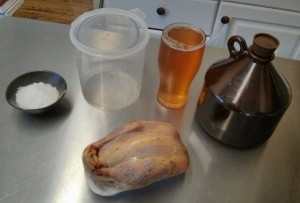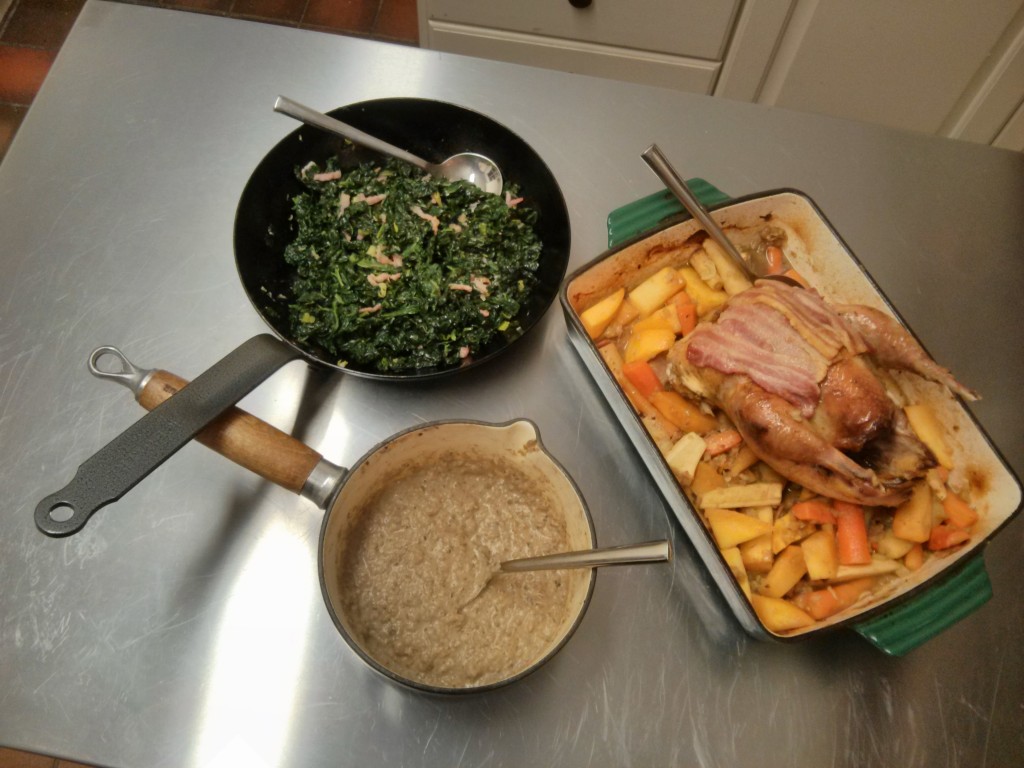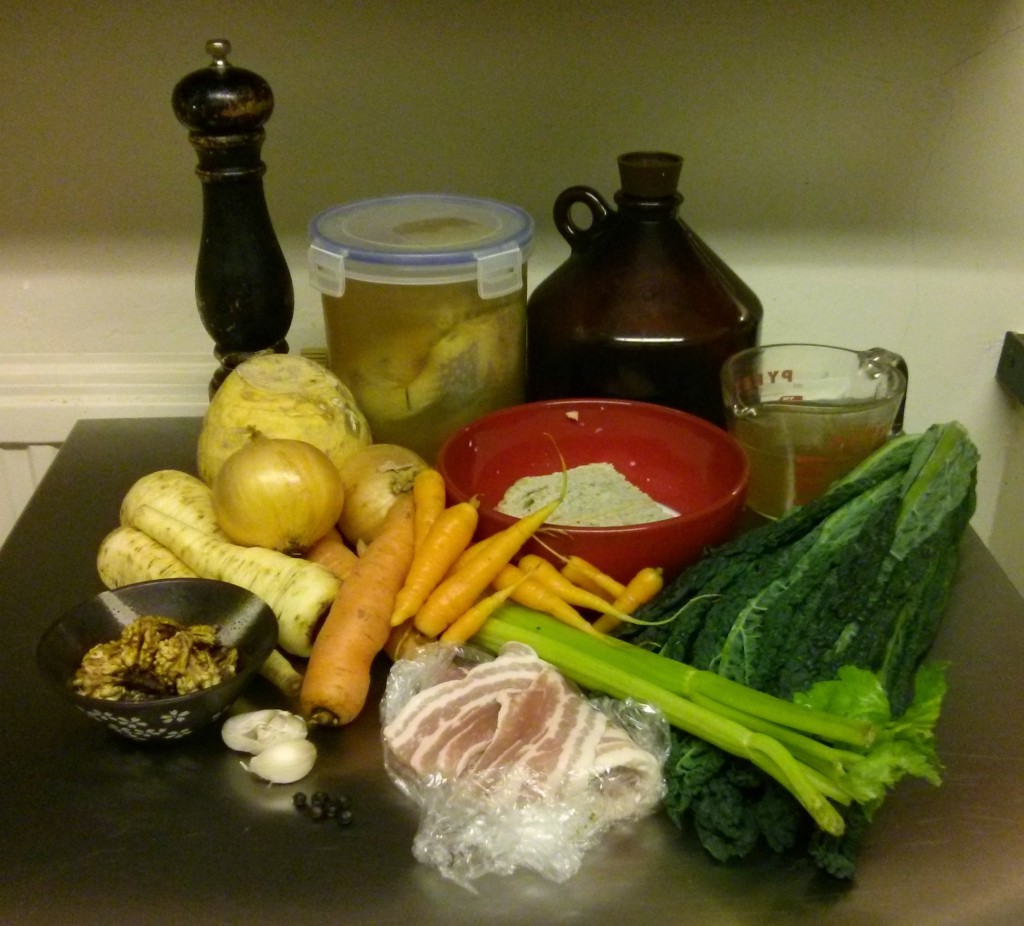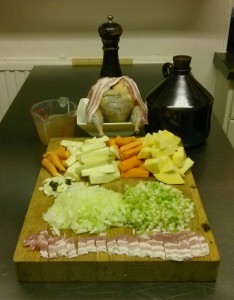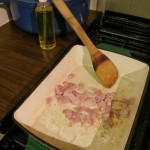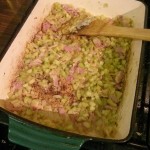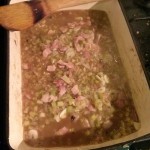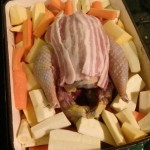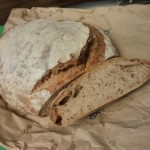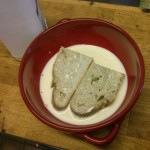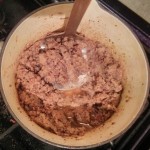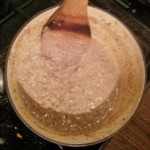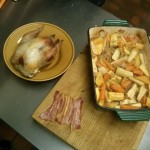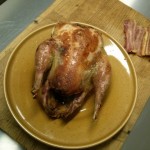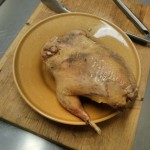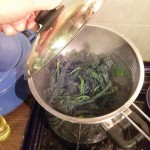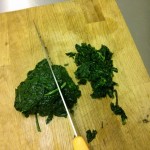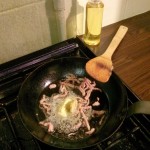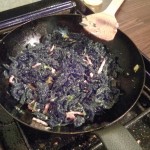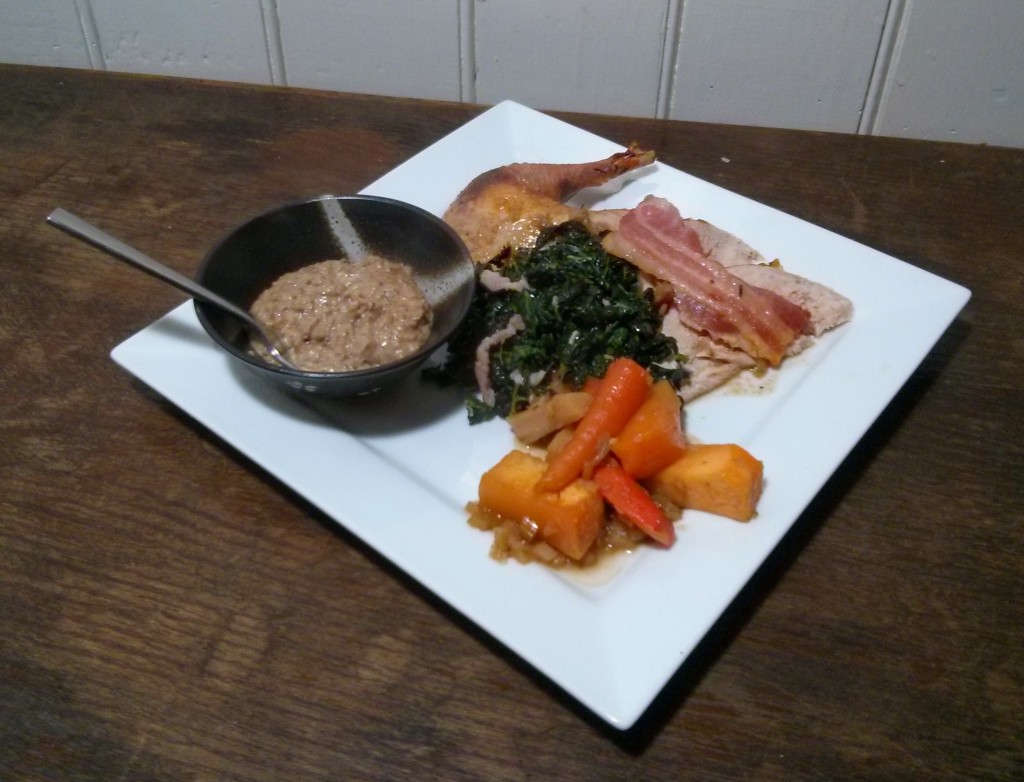… though I prefer the sound of “Beerinated Pheasant“.
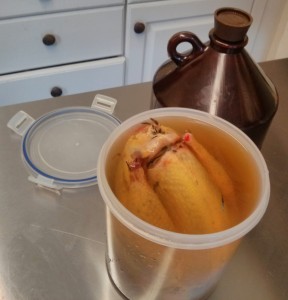
I picked up a couple of decent sized pheasant at my local butcher. It is the season… I do miss my old local in Hitchin where we knew a chap who kept us well supplied with pheasants, and other beasties, throughout the appropriate seasons. It feels a bit wrong buying oven-ready birds. But 8 quid for a brace without having to do the tedious plucking and messy gutting isn’t bad, you’ll pay more for a good chicken yielding a little less meat. While they’re “game” I don’t really think of pheasant as a “wild” bird. Almost all will have been cage raised, when you get them their crops are full of grain, and they really aren’t “gamey” – you need to give them at least a fortnight hanging to get any real decent gamey flavour. For the most part pheasant are best thought of as equivalent to a fine outdoor reared chicken, with an edge more flavour – especially around the fatty areas. If you have a good source then sometimes you’ll be lucky enough to get one of last season’s birds that has been roaming free for a year… deluxe! (Best Coq au Vin ever – or Coq au Bière!)
Anyway – the pheasant put me in mind of my old Poacher’s Pheasant Stew recipe, and I figured it was about time I did some beery cooking for this old blog thing. I’ve done beer brined chicken before and I figured: why not pheasant?
The Useful Content: Brining Your Bird
I work with a simple target 5% salt solution when brining like this, it’s hard to over-salt the bird at this strength but the solution is strong enough to have the desired affect. The recipe below is for just 1 litre of brine, as this plus one pheasant fits nicely into a 1.9 litre clip-seal container I have (see photo). You can easily make & add more brine if needed.
- Measure 50g of sea salt into a container.
- Add 100ml of hot water from a kettle and dissolve salt.
- Pour in a pint of beer – something not too bitter, a rich golden ale is good.
- Top up with cold water to make a litre of solution.
The Beer: The beer I chose for this was a take-home pint of The Brew Company “Simcoe“ (3.8%) from my local, a light ale with very grapefruity flavour notes (thus it must be craft!). I’d have preferred something with a bit more malt richness in it, but there were only a couple of other ales on and one was a stout (too dark IMO) and the other too bitter.
[Update 2014-03-15: I repeated this recipe using a bottle of Badger Blanford Flyer plus a bottle of Brain’s Barry Island IPA. Both beers I’d bought two of and discovered once was enough… too sweet. The brine worked brilliantly making for a very tasty pheasant with no hint of bitterness.]
The Salt: I used Maldon Sea Salt, posh stuff but the only thing I have handy that doesn’t have “anti-caking agent” in it. When brining a general rule of thumb that I’ve picked up from my reading is to find a “plain” salt without additives. I’ve never actually tried brining with a salt that has anti-caking agent in it though, I expect it’d probably work out fine.
Other Flavours: If you like add other flavour ingredients to this at the start with the salt. Bay leaves, juniper berries, a bit of rosemary, cracked black pepper, some crushed garlic… any of the “usual” aromatics. It helps if you give them a good crush or crumple. I’ve stuck with just beer because I was interested in how “beery” the bird would end up.
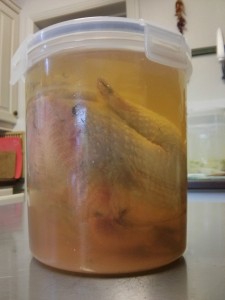 Brine It: Pop your pheasant into a container or suitably sized zip-lock bag and cover with brine. Ensure it is fully submerged. I’ve put a small plastic container under the lid of the bigger one to force the bird into the brine. If you need more solution to cover your bird then make it up as 5:100 salt to water ratio. I.e. 500g (ml) or water (and/or beer) plus 25g of salt.
Brine It: Pop your pheasant into a container or suitably sized zip-lock bag and cover with brine. Ensure it is fully submerged. I’ve put a small plastic container under the lid of the bigger one to force the bird into the brine. If you need more solution to cover your bird then make it up as 5:100 salt to water ratio. I.e. 500g (ml) or water (and/or beer) plus 25g of salt.
Time: Give the bird at least 24 hours in the brine, I’ve done a chicken for 48 hours before and it turned out fine. In fact with a bigger bird 48 hours might be better than 24.
So… here’s one I prepared earlier… remove the bird from the brine and voilà! Brined pheasant. You can now do with this whatever you want. It’ll work jointed and braised, braised whole, or simply roasted. Basically, pick a suitable pheasant recipe that you like the sound of, roasting is where the brining really has the most marked positive results. Read on for what I did with my brined pheasant…
Roast beer-brined pheasant…
… with roast veg, garlicy bacon cavolo nero, and beery walnut bread sauce.
What you need… in general:
- Beer! Just a splash here and there – you can drink the rest. :)
(Avoid the very dark and very bitter.) - A bit of cooking oil, salt, and pepper as required.
- A whole beer-brined pheasant (as per above).
- Four and a half slices of unsmoked streaky bacon.
(Other half is used in the cavolo nero.) - A cup of chicken stock (game stock would be good, veal stock would do).
- Four cloves of garlic – thinly sliced.
- 6 juniper berries – well squashed.
- A couple of sticks of celery – 5mm dice.
- A medium brown onion – 5mm dice.
- Roasting veg, all peeled and diced into chunks about as big as the end of an average sized thumb! (Well, about an inch by half an inch.) Put them in a bowl and toss with a little olive oil (or other variety) until lightly coated. I used:
- Two medium parsnips
- Two carrots
- Half a swede
- A handful of baby carrots
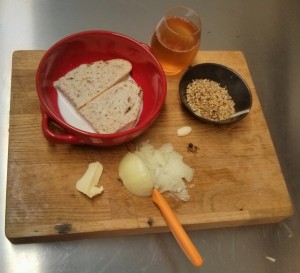 …for the beery walnut bread-sauce:
…for the beery walnut bread-sauce:
- A slice of good firm bread – I’ve used a pretty rustic sourdough.
- Some milk.
- Some walnuts – about 50g will do, chopped to “breadcrumb” consistency.
- A 20g knob of butter.
- Half a small brown onion – finely diced (2mm).
- A small garlic glove – crushed/grated/pasted.
- 2 juniper berries – squashed and chopped
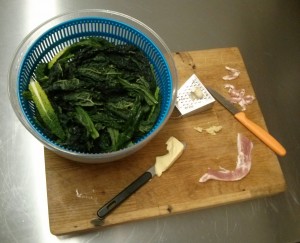 …for the garlicy bacon cavolo nero:
…for the garlicy bacon cavolo nero:
- One cavolo nero, or a suitable amount of leaves – with stems stripped out.
- Half a rasher of streaky bacon – finely sliced.
- About 20g of butter.
- A small clove of garlic – crushed/grated/pasted.
At least an hour in advance, put your firm bread into a bowl (cut/tear it if needed) and douse with just enough milk to soak it.
Pre-prep all the ingredients as described above.
Get the roast going: Preheat your oven to 230°C. Roughly chop two strips of streaky bacon and sizzle in a little oil. I do this directly in my cast iron baking dish. When the bacon is just beginning to brown toss in the diced onion and celery and sizzle this until the celery and onion is just lightly browning as well. At this point pour in the chicken stock and half a cup of the beer. Use the liquid to scrape off any browned-on residue, add the garlic and juniper berries, and bring this lot to simmering point. Now you can turn off the heat and place the pheasant in the middle of the roasting-tin breast-side-up. Bard the pheasant with a couple more strips of streaky bacon and pack the vegetables around the bird. Now into the oven with it – turning the oven down to 180°C immediately. Set a timer for 45 minutes.
Make the beery walnut bread-sauce: Lightly brown the walnut crumbs in a small saucepan, add the knob of butter and the onion. Cook on low heat for 2 minutes to just soften the onion. Add the garlic and juniper berries - which have both been crushed and finely chopped. Soften the spices for a minute before adding the milk-soaked bread and any milk with it, roughly tear this up. Heat and stir/mash to combine in the bread – the sauce should thicken considerably. Wet it with some additional milk if it isn’t a paste already. Add a splash of beer at a time, tasting as you go with an aim to get a beery flavour without undue bitterness. As you’re doing this you can also add salt to taste, which can balance the bitterness. As the sauce simmers it will continue to thicken, once you’re happy with the flavour imparted by the beer start adding milk instead in order to bring the sauce to a suitable consistency (which is up to you really, I aimed for a “heapable” paste). Put a lid on it and set it aside somewhere warm.
Turn your attention back to the roast: By this stage your roast has probably reached 45 minutes. Remove from the oven, I checked the internal temp deep between the leg and the body – 65°C, fine. Remove the bird from the baking tray and place aside on a warmed plate. Toss the vegetables in the roasting dish to get a bit of moistness on them and pop them back in the oven. They’ll probably need at least another 20 minutes until they’re suitably cooked. Optional: Take the bacon off, rub the breast with a little butter, place the bird under a low grill and carefully brown the breast. This isn’t just cosmetic, but it makes more of a cosmetic difference than a flavour difference – thus optional. Place the bird breast-side-down in its warmed bowl, putting the bacon next to it, cover with foil and put somewhere warm to rest. (I popped it into the top-oven, which is nicely warm while the veg are still roasting.)
Fry up the cavolo nero: Simple: steam the leaves in a colander over boiling water until “tender” (a couple of minutes). Let them cool a little before chopping roughly. In a fry-pan lightly brown the streaky bacon in a smear of oil. Pop in the nugget of butter and melt this then add the garlic. Let the garlic sizzled just a little, 15 seconds is plenty, then put the cavolo nero in and toss vigorously to coat the leaves in garlicy bacony buttery goodness. Done!
Time to “plate up”: The roast veg should be done by now, so we’re ready to serve. How you present this is up to you. I’d flip the bird back to breast-side-up, pop the bacon back on top, and take the lot to the table as-is and carve & dish-out to warmed plates at the table. The bread-sauce may need a little warming through before going to the table. On the plate I’ve simply put down a sample of each item, a small bowl of the bread sauce, and the beery juices from the pan with celery & onion are drizzled here and there.
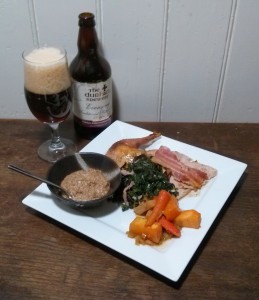 Serve, of course, with some good beer. If you’ve used take-home beer in the dish like I did it is probably a bit flat & dead by now if you still have any left. I served this dinner with Durham Brewery “Evensong” (5%)… which was a perfect match to a rich game dinner. The beer has a solid toasty backbone, it’s malt-forward and compliments both the season and this autumnal meal. My check-in note for the beer was: “Easy drinking amber ale. Very good with a bit of roast pheasant. Robust yet smooth flavour of maltloaf, cola, and summer hay.” The brined pheasant retained an excellent moistness thanks to the brining and had picked up a subtle beery note, too subtle perhaps, though it seemed more distinct when I tried some cold the next day. The beery notes were more to the fore in the bread sauce and pan juices and really are best described as “beery” – no fine nuances. It had tended a little to the bitter side in the pan juice, but this was no trouble as this was used sparingly anyway. Overall – a success. I’d like to try brining pheasant with some different beers to test the differences – something like my side-by-side IPA beer batter test, but I really need to invite some folk over to test the results for this one!
Serve, of course, with some good beer. If you’ve used take-home beer in the dish like I did it is probably a bit flat & dead by now if you still have any left. I served this dinner with Durham Brewery “Evensong” (5%)… which was a perfect match to a rich game dinner. The beer has a solid toasty backbone, it’s malt-forward and compliments both the season and this autumnal meal. My check-in note for the beer was: “Easy drinking amber ale. Very good with a bit of roast pheasant. Robust yet smooth flavour of maltloaf, cola, and summer hay.” The brined pheasant retained an excellent moistness thanks to the brining and had picked up a subtle beery note, too subtle perhaps, though it seemed more distinct when I tried some cold the next day. The beery notes were more to the fore in the bread sauce and pan juices and really are best described as “beery” – no fine nuances. It had tended a little to the bitter side in the pan juice, but this was no trouble as this was used sparingly anyway. Overall – a success. I’d like to try brining pheasant with some different beers to test the differences – something like my side-by-side IPA beer batter test, but I really need to invite some folk over to test the results for this one!
Enjoy!
